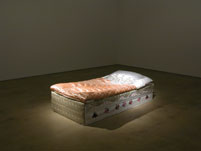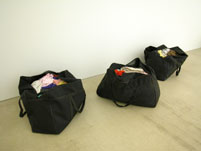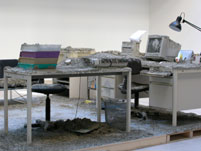| |
||||||||||
|
Mobilien | Movables |
||||||||||
| |
||||||||||
|
|
|||||||||
| |
||||||||||
| Artists Olga Chernysheva (RU), Jimmie Durham (USA), Tamara Grcic (GER), Renée Green (USA), Seth Price (USA), Erzèn Shkololli (Kosovo) |
||||||||||
| |
||||||||||
|
Opening Exhibition will be opened by LR Dr. Elisabeth Zanon, head of the Tyrolean’s government office for cultural affairs |
||||||||||
| |
||||||||||
|
"Movables" are portable and transportable objects usually associated with interior furnishings which are laden with a history that extends beyond their everyday form. The group of "Movables" presented here in this exhibition were artistically transformed by the internationally noted artists Olga Chernysheva, Jimmie Durham, Tamara Grcic, Renée Green, Seth Price and Erzèn Shkololli. They are sounding out the relation between an object of everyday use and its narrative potential as a medium for storing memories. Detached from their original context and previous function these objects become carriers of collective and personal hi/stories through the artistic process. They become repositories of an absent political and social reality that assumes symbolic presence through the material character of the objects. In a subtle balance of revelation and concealment, these "movables" include aspects of the transitory and of the absent other as well as the return of an internalized trauma. A chair, a bag, a bed, a photograph of a rug, a children's playground object, an office cabinet thus assume an allegorical quality, opening up new meanings and perspectives of the past and of the present. Trivial objects that are familiar to everyone come to trigger off a mode of perception that gives an emotional and reflective view of a specific (political) situation or history that would otherwise have simply gone unnoticed. "Membranes" (2001) by Olga Chernysheva consists of eight life-size colour photographs depicting Oriental rugs hanging on a wall. The artist is referring here to a Russian custom of adorning homes with one or more wall rugs as a sort of status symbol. As a result of the economic crisis that post-communist Russia faced during the nineties, many people have been forced to sell their rugs. Olga Chernysheva's works thus refer to a characteristic object of everyday life which – transformed in photographic paper – points to a material and symbolic loss in which the current political and social reality is summed up in condensed form. In the installation
"Travelling Bags" (1999) by Tamara Grcic seven
identical black nylon travelling bags that are available at cheap shops
assume a sculptural and emotional presence. Their zippers are open,
revealing pieces of clothing that have been neatly folded together
– the shells of people not present who are obviously on the
go. Detached from the spatial and temporal continuum of everyday life
the bags become emblematic for the worldwide migration movement by
which millions of people are affected. A seigniorial interior at first sight is the starting point of a critical mise-en-scène and scrutiny of racist-social role patterns by the Afro-American artist Renée Green. Her installation "Mise-en Scène: Commemorative Toile", the first version of which could be seen in 1992, consists of a group of vintage furniture whose cushions are covered with fabric the artist designed by recourse to historical images. This pattern which can also be find on the wallpaper belonging to the ensemble, does not, however, depict a bucolic idyllic scene as one would expect from a seigniorial interior of 1800. To be seen are rather bizarre as well as brutal historical scenes from the Haitian slave revolt of 1804. "Bed" (1999) by Erzèn Shkololli links Kosovo's Muslim culture with his obsession with death. This bed is designed extending to the smallest detail – the shiny fabrics, the magnificent embroidery. Shkololli places it in the middle of the room like an altar-like appearance. Shkololli, Migjen Kelmendi writes, "has the rare talent of being able to strip ordinary things of their everyday character." Laden with the most recent historical events in Kosovo Bed becomes an allegory of death that also alludes to peace. Primary materials of "Modern Suite" (2002) are shots from Internet catalogues for children's games for outdoor playgrounds. Seth Price, born in East Jerusalem and based in New York, collected and assembled this static imagery to create a video. Reinforced by the music, these playground objects assume something menacing and melancholy when they are depicted without children. What Price reveals here are adult fantasies of spaces for children that have become architecture, both kitsch and sometimes real extravagance. The installation "The Petrified Forest" (2001/2004) by Jimmie Durham responds to the architectural setting of the hall in the basement. The "Petrified Forest" is made up of office furniture such as cabinets and desks as well as office equipment, computers, fax machines, lamps, etc. over which Durham has poured layers and heaps of cement so that everything is only partly visible like after a landslide. The public is led through this "forest" on narrow paths. It is a forest that evokes a disconcerting catastrophic mood as well as a sense of anarchic liberation from the fully controlled everyday world of administration. |
||||||||||
| |
||||||||||
|
The exhibition is supported by Special thanks to |
||||||||||
| |
||||||||||
|
||||||||||


